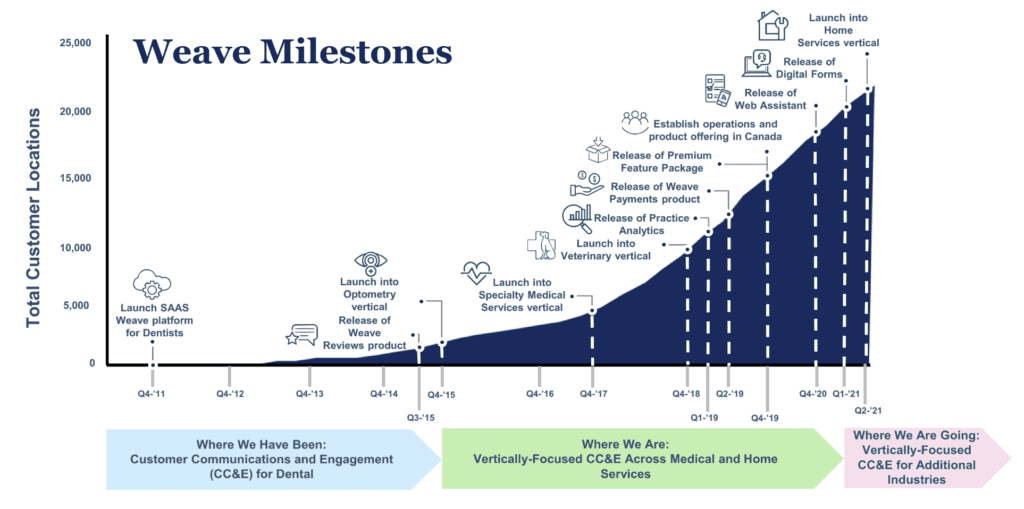
So a great founder doing tens of millions in ARR recently asked me what I thought of doing a “small IPO” as they approached $100m in ARR. It’s something we don’t see too often these days, as $200m+ ARR sort of became the new floor to IPO in SaaS.
But I thought I’d take a deeper look at one example, Weave. Weave started off as a dental ERP and comms platform (including VoIP / phone), and then expanded beyond that as it scaled. Today, it crosses dentistry, optometry, veterinary, physical therapy, specialty medical services, audiology, plumbing, electrical, HVAC, and other home services.
It IPO’d in November 2021 and today is doing $130m ARR, growing a respectable 30% year-over-year.
But while it IPO’d at a $1B valuation just this past November, today, its market cap is only $218m. Yes, it’s at $120m ARR and is valued at less than 2x ARR. And that’s including $135m in cash on the balance sheet. It’s a tough outcome for a team that is working hard to scale well into the nine figures of ARR.
5 Interesting Learnings:
#1. NRR of 103% and GRR of 94%. While these wouldn’t be great metrics if Weave were enterprise, they are solid for SMBs SaaS. Many SMB SaaS companies struggle to hit 100% NRR and 80% GRR. Weave has a solid SMB base to build on, and has done a good job steadily increasing NRR, up from 97% in 2019.
#2. 56% Gross Margins overall, Negative on Hardware and Services. This is a challenge so many SMB businesses have that also have a services component and a hardware component. As you can see below, the SaaS itself has a typical 73% gross margin. But it then loses real money on onboarding, at -124% margins, and real money on hardware, at -183% margins. Historically, Weave gave away several “free” phones with each new account. Weave has worked hard to get these to blend together to 58% gross margins, which is impressive. Yes, these really can be seen as customer acquisition costs, and they are: “We consider the net costs of onboarding and hardware, in addition to our sales and marketing activities, to be core elements of our customer acquisition approach.”
But it’s also a reminder how hard it is to combine services, hardware, and software and make money from SMBs.
#3. Majority (59%) of its customers still pay monthly. Many SMBs just prefer it.
#4. Stripe deal has a 3-year term. Weave has added payment processing to its services, and as part of that, uses Stripe per a 3-year term agreement.
#5. About 20,000 customers, so about $5,000-$6,000 per year per customer. A fairly standard SMB price point.
And a few other interesting leanings:
#6. 907 employees at IPO, so about $150,000 revenue per employee. That’s fairly low revenue per headcount, although being headquartered in Utah with a large presence in India does seem to bring costs down.
#7. Series C ($5.35 per share) and Series D ($14.90) shareholders underwater, at least for now. With a current stock price of $3.37, the Series C and D investors are substantially underwater. A reminder growth investing isn’t a space you automatically make money at. No matter how it may have seemed in 2021. The Series B investors invested at $1.69, so they’ve got a profit, but not a huge one.
#8. Plenty of cash, not burning that much. While Weave isn’t yet cash-flow positive, it isn’t burning all that much for being at $130m+ ARR. They have $128m in the bank from the IPO and are only burning $7m a quarter. Weave isn’t going under and it isn’t going anywhere. It’s just in a bit of slow burn mode now.
So why the terrible revenue multiple? First, Weave’s growth has dramatically decelerated. It was growing 75% in 2020, year-over-year. Second, the company had significant financial control issues, which spooked Wall Street. And third … well, I don’t know about third. The business has a lot going for it, even if it’s not the rocket ship it looked like 12-18 months ago.
I’m hoping as we come out of this SaaS multiple compression, Weave roars back with a billion+ valuation again. While growth isn’t epic at $130m ARR, it’s solid, it has 100%+ NRR from SMBs, and it isn’t burning a lot of cash. It certainly deserves a much higher valuation than it has.
And it should make you wonder a bit if your valuation in the last round was much higher than Weave’s market cap. Especially if your growth isn’t crazy high.
And a few related ones in this series:
- 5 Interesting Learnings from Zendesk at $1.6 Billion in ARR
- 5 Interesting Learnings from Sprout Social at $240,000,000 in ARR
- 5 Interesting Learnings from Monday.com at $400,000,000 in ARR







